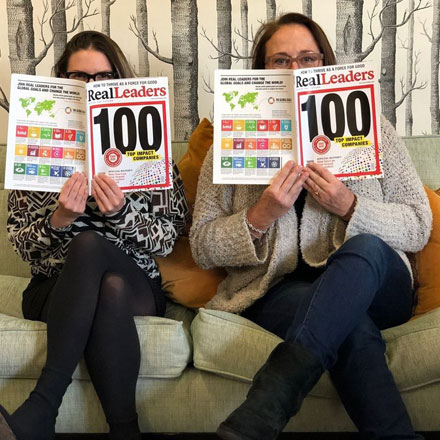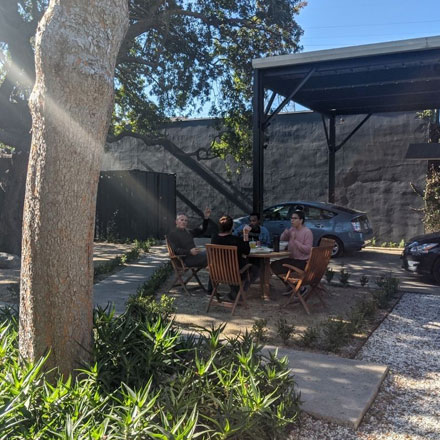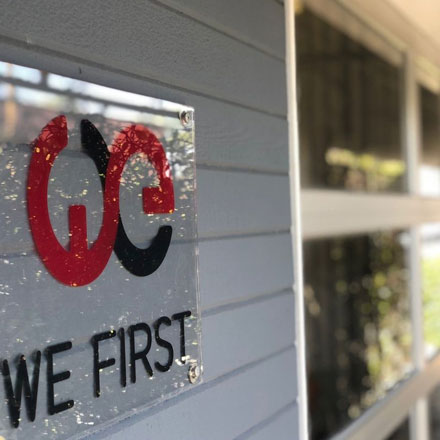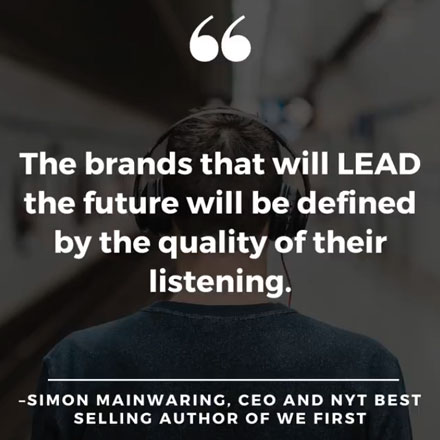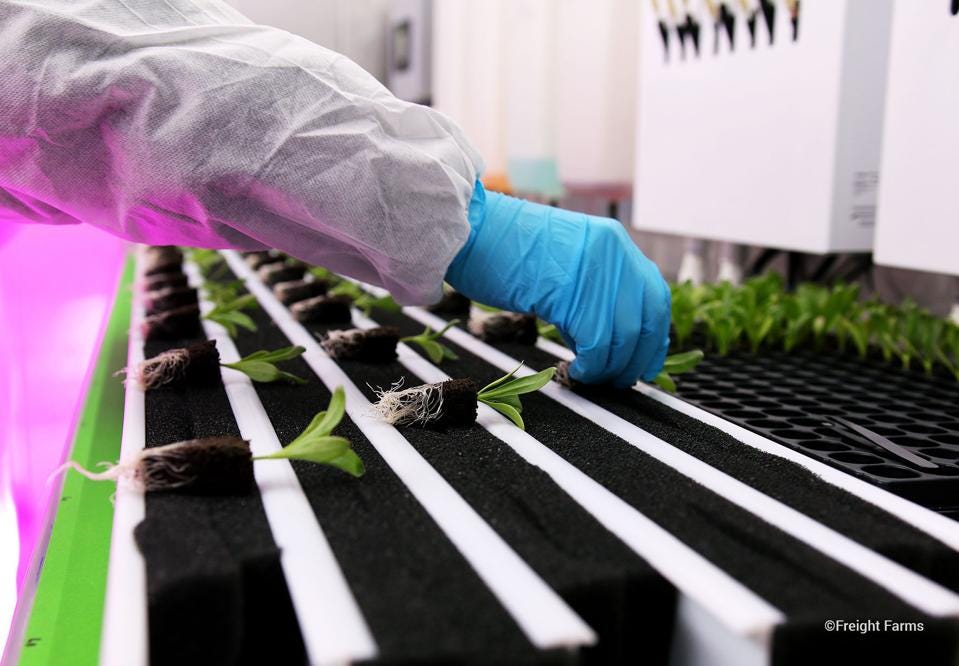
Blog
Purpose At Work: Freight Farms, A Boston Startup Growing Global Solutions To Food Insecurity And Injustice
In 2010, entrepreneurs Brad McNamara and Jon Friedman planted the seeds intended to boost “urban agriculture” to become a more viable and competitive alternative in the food industry. They put ‘We’ First, focusing on rooftop hydroponic greenhouses. What that really meant was a focus on parts of the country that couldn’t support traditional farming methods.
Now, their company, Freight Farms, is the world’s leading manufacturer of container farming technology. Today the company is a model of Lead With We best practices, working as it does to empower anyone to grow food for their own community.
Those communities Freight Farms has reached span all 50 states in the US, as well as 32 other countries. To date, about 420 of its prefabricated steel farms span the globe, owned and operated by 750 growers the company trained, all connected through its proprietary vertical farming software, farmhand. That worldwide community of farmers are together addressing global problems of food insecurity, suboptimal nutrition, and unsustainable extractive agriculture.
With its global infrastructure, CMO James Woolard tells We First, the company aims to expand its efforts to revolutionize local access to food for a more sustainable future. Not only in terms of the environment, but by increasing local community resilience and security.
“Together,” the company says, “With our team and network of farmers we hope to build a future-facing and inclusive world.”
Containing the problemMORE FOR YOUIn Crypto ‘Arms Race’ For Mass Adoption, Companies Ink Sports Sponsorships Worth Hundreds Of MillionsCAA Signs Jenkins The Valet: Is This A Sign That Hollywood Is Embracing NFTs?HPE’s Sandy Ono On Insights At Hyper Speed To Drive Growth And The Value Of Marketing’s Currency
The Freight Farms model and those like it are solving multiple interconnected challenges. For example, the number of food deserts in the US, Woolard explains, translates not only to inequitable nutrition but to an environmental challenge, too. Members of “communities that just do not have access to fresh, nutritious food, have to certainly move a considerable number of miles to find a grocery store. And that’s shocking” enough. “And then secondly, the amount of food that’s moved across the US” is also staggering and environmentally unsustainable, he says. “What you’re eating is moved an average of 1,500 miles,” for example “from California to where you’ve actually purchased the product … the amount of waste is so embarrassing for me and my generation.”
Woolard challenges those of us who come from a food-privileged socioeconomic stratum, “to look in our fridge and see a small microcosm of [how] we take food for granted, and we massively over-consume in the Western world.”
The problem is different — scarcity and not overabundance — in other parts of the world. “Globally,” Woolard says, “think islands, think Caribbean, Cyprus, Tasmania — places where they don’t have food security. They are completely dependent on importing food. The Bahamas alone,” he says, “imports a billion dollars worth of food a year. So as soon as there’s a chink in the supply chain … there’s so much volatility and risk within it — they have no security.”
But even in the relatively well-off US, Woolard reveals, “The average grocery market …has only three days of food in it. And when there’s a run on Walmart” — such as in the early days of the pandemic — we all learned, “it’s only three hours.”
For these reasons — though Woolard prefers to avoid “adspeak” — “It’s so important that we’re able to move the farm, not the food. That’s the key. If you can move a farm that creates a local point of production, then you can give an area food security.”
But how, exactly, do you move the needle by moving the farm?
“The big a-ha moment,” according to Woolard, “in democratizing access” was to make farms more “modular and scalable … So, ‘What if we put our farms in freight containers?’” Woolard says the founders asked themselves. “That provided a modular … solution where we could control the environment within the container, completely seal it — and we could move it anywhere.”
Around the time of the company’s infancy a decade ago, shipping containers were already top of mind for some of the most visionary companies and designers, such as Antonio Bertone, Puma’s CMO: Woolard points to his Puma City, the portable assemblage of two dozen 40-feet long and 11-ton reinforced, corrugated steel shipping containers stacked like Lego into a multilevel retail pavilion, bar, and event space.
And in London the world’s first pop-up mall, made entirely of shipping containers, debuted — there are three Boxpark locations now spread across the city’s boroughs. Starting in the early 2000s, shipping containers had already become more versatile and visible around the world. They took the form of pop-up shops, restaurants, food “trucks,” office, and retail spaces. The Dordoy Bazaar outside Bishkek, Kyrgyzstan, for example, features about 7,000 double-stacked containers, workplaces to 20,000 vendors and their staff.
But using containers for high-yield, low-water, portable, variable farming — that would have the ancillary benefit of cutting agriculture production and management costs, uncomplicating logistics, expanding reach, and decreasing obstacles to wider uptake. So, the company began retrofitting with its new technology widely available, perfectly-sized, shippable-anywhere freight containers. Such a radical shift in farming might someday be seen as revolutionary and influential as, say, the invention of the cotton gin.
Demand — a function of both the worsening of the environment, food justice, and the economy, as well as the company’s excellent storytelling and support — started slow, but soon soared. Of late, Freight Farms, though still relatively small, has doubled its unit sales year after year, the company reports.
Why? Modularity equals accessibility. In the frozen tundra of Canada and Alaska — you get a farm! In the scorching, windswept deserts of the Middle East — you get a farm! Blighted, smoggy urban wilds? — you, too, get your very own farm!
What kind of farm? The tenth iteration of Freight Farm’s core product, the Greenery S, is a modified new international, intermodal freight container with 320-square feet of soilless, hydroponic growing space. It’s able to produce between 300 and 500 varieties of crops — lettuces, leafy greens, herbs, some root vegetables, edible flowers, and brassicas (cabbage, kale, broccoli, cauliflower, turnip, and mustard), etc. — in a closed-loop system consisting of four rows of panels on flexible moving racks. Equivalent to about two acres of traditional farmland, Woolard says, the container can support 8,000+ living plants at any given moment.
And from it, every Freight Farmer, despite their wildly differing origins, are all gaining the power of growing food for their own communities, all massively shortening the distance that food travels from farm to table. Best of all, container farms can be the source of high-quality and sustainable produce, 365 days a year.
The green thumb of the IoT
But surely this product doesn’t allow for a “plant it — and walk away until it’s ripe” method? You can bet the farm, it doesn’t.
Not to say the operator needs an advanced Ag degree or decades (literally) in the field. “This is critical,” says Woolard: “That anybody can do it; you don’t even have to be a farmer to start your business.” It takes Freight Farmers an average two to three months under the tutelage of the company’s academy program — a kind of “farm school” — which provides on-boarding, training, continued education, and a community hub — as well as 24/7 support to help farmers speed the plow.
The basis of the company’s more-or-less turnkey platform is the optional IoT technology, its farm management software, farmhand. The system automates most of the process, helping farmers stay in control of their farming operation with help monitoring the farm and driving efficiency — and therefore yield — in real-time. Farmhand automatically optimizes all essential pillars of the farm, all the main growing variables — air, light, water, space, and control — based on the desired crop, and creates the perfect environment no matter where the farms are in the world — no matter what’s happening outside the container.
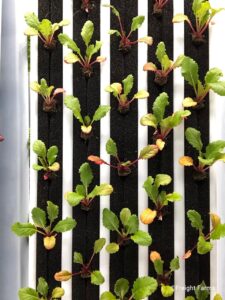
Putting the green where the lettuce is
Initial funders got behind the idea of vertical farming in freight boxes — but they really loved “the value of that connected network,” says Woolard, “the prescriptive operating system.” It’s called “controlled environment agriculture technology,” and it drives many investors’ confidence that it works to triangulate benefits:
“Our software — and you, with your experience –” says Woolard, “We’re able to then tweak the variables of say, temperature, or light, so you can grow the optimum yield and the optimum blend of crops.
“That means you’re getting a lot of data on the best ways and different combinations of seeds and crops that you can grow in the container.”
Throughout the growing process, farmhand might, for example, notify you if it detects internal climate conditions falling outside of your targets. And — with your permission — the software can also transmit data to company support staff in case you need a little — or a lot of — of help. That provides more data points that continually improve the program’s AI aspects.
“So, from a purely financial point of view, investors, like the farmers, are seeing the ability to scale the modularity … significantly and quickly — but also the power of the technology and the data,” Woolard says.
But a turnip doesn’t grow in a day. “The first seven or eight years,” says Woolard, “were just really proving out the concept …But there was belief early on, so there was investment from Spark Capital, for example, in the idea. And then really it took off two years ago with the series B or 18 months ago.”
Indeed, Freight Farms raised $15 million Series B led by Osrpaie Ag Science, a venture cap firm specializing in sustainable agriculture. Spark also participated in that recent round, bringing the company’s total funding to more than $28 million.
The seeds of Woolard’s purpose
The Oxford-educated Woolard never worked for a startup before. He began his career as a product- and senior product manager at L’Oréal, followed by 15 years at Adidas and its subsidiary, Reebok, where he concluded as a senior director of global marketing for various units. “But there came a point where I wanted to make more of an impact on growing a smaller business that was commercial,” he says, “but [one that] also had purpose, and had a benefit to communities and the wider world.”
Woolard was no stranger to a Lead With We mentality and methodology. Adidas, the veteran apparel maker had worked since 2017 with the nonprofit Parley Ocean Plastics to transform plastic waste into symbols of change by upcycling intercepted marine plastic debris for use in high-performance, sustainable sports gear: The partners turned flotsam into sneakers. More recently, and on the for-profit side, Adidas has pre-competitively partnered since May 2020 with its ostensible rival, New Zealand/American footwear newbie Allbirds, to create the most carbon-neutral shoe on the planet.
But Woolard was primed for even more purpose activation — to work on solving equally messy challenges. When he encountered — “stumbled across, to be transparent” — the mission of Freight Farms, he saw “It’s big and it’s important,” he says. “And maybe if I put my best foot forward and bring my A-game, I can help grow this business. It’s rewarding on the commercial side, but more importantly, this business does good. And this business can help have a local impact and a global result.”
“Dirt is not our competition”
Woolard gets impatient when people ask whether the rapid rise in AgTech over the past decade will ever ring the death knell for traditional farms. “I always emphasize that we’re complementary,” he says. “We’re not against soil — we want to be the viable solution in places where you can’t traditionally grow your crops in … not great … soil.”
On the other hand, there are some tangible benefits of container farming, according to Woolard. He points first to the “efficiency and water usage. We use 98 percent less water. And I think what we give is more consistency and control that allows you to plan” better.
But does produce grown in a freight container taste like a science experiment? On the contrary, Woolard insists. “I get most excited because we do well in the ‘Pepsi Challenge.’ And the reason is, it’s super fresh. It’s not traveled … at all. It’s super clean, so you don’t have to rinse our produce. It’s nutrient-rich because it’s precision-grown, with the best blend of nutrients directly put into the plant. And obviously, because it’s so fresh, it lasts longer.”
Experts tend to agree. The company relies on revered local chefs and trusted Community Supported Agriculture farmers’ markets to “validate the quality of the produce. All of our successful customers have built [their businesses] through CSA farmers’ markets,” Woolard says.
“And then there’s about a 50 percent dot-com, DTC business. It’s basically the classic advocacy model of people saying, “This absolutely tastes like some of the best lettuce I’ve ever had. I can taste the freshness. I can taste — the taste.”
The stakes of a purpose garden
Freight Farms credits its success to attention to four mainstays of its community: Its employees, customers, partners, and the planet they all serve.
“As you can imagine,” says Woolard, “We have a young purposeful workforce of 50 or so people, listening to the stories and the mission, which really motivates everybody to drive and grow this.
“And then equally, supporting the small business farmers is really important to all of us, because unless we can make this a sustainable and economically profitable business, we’re not going to get to the scale to have the impact that we want from a purpose and planet point of view … it will allow us to redistribute the profits in a responsible, purposeful way at scale.”
Between 60 and 65 percent of the Freight Farms customer base consists of those small business farmers — “entrepreneurs looking to run a profitable business, generate a hundred to $120,000 of revenue a year from their farm,” Woolard says. “And they really are that classic entrepreneur that wants to give something back to the community, but turn a profit.”
Most who follow the company’s prescriptions and guidance, and subscribe to the gamut of support options, can break even after two or three years, Woolard says.
Another 15 percent — and growing — of the vertical farms are sold to educational institutions. “We have 35 college campuses in the US that use our farms.” Students at Auburn, for example, get access to the educational element of Ag Tech, nutrition, and distribution. Institutions can get grants. The company has sold to an equal number of K-12 schools as part of the trend of teaching kids about the origins and production of our food.
In 2020, Freight Farms formalized a strategic national partnership with French food service and facilities giant Sodexo to grow food onsite at educational and corporate campuses nationwide. That fits with Sodexo’s campaign over the past several years to take a bite out of food waste. Sodexo’s focusing on what it can do at the more than nine thousand sites it services in North America by influencing behaviors among its millions of customers. It adopted the “Save the Food” mantle from the national public service campaign developed by the Ad Council and the Natural Resources Defense Council. Simply, methodically, logically, and emotionally, Sodexo engages its customers to reduce, reuse, and recycle instead of contributing to the “nearly $165 billion in wasted food that Americans throw out annually.” Container farming is one strong pillar of those efforts.
The remaining 25 percent of Freight Farms’ containers are run by not-for-profit entities. “And that’s really where you see that true purpose and impact that we can have,” Woolard says. Some use the farm to better balance food justice, or ameliorate homelessness, or even vocationally train disabled and intellectually challenged people, even as the programs empower the farmers.
As one example, five hundred women and children at Lotus House, a women’s refuge outside Miami, Florida, benefit in multiple ways from their farm. It provides not only food but vocational therapy and viable job skills:
“A lot of the families who come have a history with food insecurity, lots of skipping meals, not being able to afford food throughout the month, only being able to afford what’s available in the corner store, so processed foods and candy,” says Jackie Roth, project coordinator at The Lotus House. The farm is helping change that cycle, one head of lettuce at a time.
Freight Farms has also partnered with DC- and New York-based Arcadia, which offers easy access for communities and businesses to connect to affordable renewable energy power. The new collaboration will enable US-based Freight Farmers to match 100 percent of their electrical consumption with solar and wind energy. The collaboration will both increase the sustainability of indoor farming while simultaneously driving demand for more clean energy.
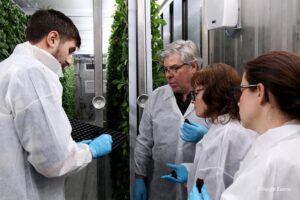
“Pests” stunting industry growth
Despite its steady expansion, Freight Farms and its industry still face several uphill climbs to wider uptake. Woolard summarizes three of the most thorny:
- Access & affordability. “The biggest challenge that we face, completely honestly –my main focus — is increasing our farmers’ access to capital. The current unit costs $140,000. Because container farming is still relatively new, the traditional worlds of business banks and even the USDA’s [Farm Service Agency] — They want experience in farming, and experience in business. Whereas we’re about access to people.” And “even though it’s bloody hard to move public policy and government,” the company’s working with like-minded partners formally and informally to influence public policy: For example, the USDA recently infused [hundreds of millions] of relief funds into the ag-sector: “How do we convince the institutions that this is something you should support from a loan and financing point of view?” One option is a so-called Aggie Bond: a low-interest middle ground between private and federal financing, managed at the state level through a federal-state partnership that allows private lenders to get federal or state tax-exempt interest on loans for beginner farmers to purchase farmland, equipment, buildings, and livestock. Freight Farms offers potential farmers education regarding financing options.
- Widening buying networks. “We need to be able to go to a Whole Foods and sell the reason that this product needs to be in your range … with our storytelling around the transparency and the origin of the product. And that’s a huge push for us to have — more formal buying network partnerships that help support our customer network.”
- Generational/organizational resistance. “Since I started my career … leadership has been very top-down … I think the UK, Germany, and the US are the most top-down, alpha male, ‘do- what-I-say” business cultures. “But what I’m most optimistic about is the generations below me. I’m accountable to a generation of people that hold my feet to the fire for this not to be bullshit, right? I think they’re way more purposeful and authentic than I was at their age. And that gives me hope because they really mean it. We’ve totally messed them up with what we’ve done, and they know that they now need to solve this … They know the politicians won’t do this very well. Whereas however much business can get a bad rap making hedge funds more money, if used the right way, business can have the quickest impact … The right companies collaborating in the right way and moving capital against it very quickly, business can actually make the biggest impact … This generation coming up … believes that companies need to be way more accountable for how they operate, beyond delivering those rich people better 401(k)’s. And then they will make better decisions about the products and brands that they buy into, based on the right values and the right way of working. And they will smell if it’s not authentic.”
Freight Farms’ purpose is authentic: “Purpose, people, planet is what we’re doing.”
If you’d like to dive deeper with more purpose-led companies like Freight Farms, check out the Lead with We podcast here, so that you too can build a company that transforms consumer behavior and our future.


